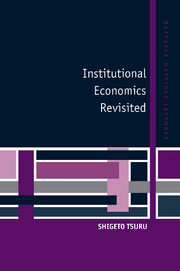Book contents
- Frontmatter
- Contents
- Preface
- Institutional Economics Revisited
- CHAPTER ONE Reappraisal of Marxian Political Economy as ‘Institutionalism’ in the Broad sense of the Term
- CHAPTER TWO The Methodology of Aggregates: Keynes vs. Marx
- CHAPTER THREE Marx vs. Schumpeter on Business Cycles
- CHAPTER FOUR Institutional Economics in America: Veblen
- CHAPTER FIVE Modern Institutionalism
- CHAPTER SIX The Future of Institutional Economics I: In Place of GNP
- CHAPTER SEVEN The Future of Institutional Economics II: The Mixed Economy as a Mode of Production
- DISCUSSION, AND COMMENTS, BY SHIGETO TSURU
- BIOGRAPHY OF SHIGETO TSURU
- References
- Index
CHAPTER FIVE - Modern Institutionalism
Published online by Cambridge University Press: 13 May 2010
- Frontmatter
- Contents
- Preface
- Institutional Economics Revisited
- CHAPTER ONE Reappraisal of Marxian Political Economy as ‘Institutionalism’ in the Broad sense of the Term
- CHAPTER TWO The Methodology of Aggregates: Keynes vs. Marx
- CHAPTER THREE Marx vs. Schumpeter on Business Cycles
- CHAPTER FOUR Institutional Economics in America: Veblen
- CHAPTER FIVE Modern Institutionalism
- CHAPTER SIX The Future of Institutional Economics I: In Place of GNP
- CHAPTER SEVEN The Future of Institutional Economics II: The Mixed Economy as a Mode of Production
- DISCUSSION, AND COMMENTS, BY SHIGETO TSURU
- BIOGRAPHY OF SHIGETO TSURU
- References
- Index
Summary
In summarizing the chronological tree of institutional economists, Allan Gruchy wrote:
Although there has been some overlapping of generations of institutionalists, one can discern three well-defined periods in the development of institutional economic thought. The first period is associated with Thorstein Veblen's work, which was done in the years 1890–1925. The second period includes institutionalists such as Wesley C. Mitchell, John R. Commons, and John M. Clark who came after Veblen and worked during the years 1925–1939. The third or current period is that of the present-day institutionalists such as John K. Galbraith, Clarence E. Ayres, and Gunnar Myrdal whose contributions to institutional economics have been made primarily since 1939.
One can immediately see in the above mentioned group of economists that there is nothing like sectarian homogeneity which usually characterizes a particular school of economists. This is perhaps because institutional economists, all of them, emphasize open models in their methodological approach-models which do not exclude any fresh orientation in different directions.
Besides, Veblen, from whom the institutional school is said to have started, was in many ways an eccentric man. Although he displayed flashes of insight which opened the minds of his colleagues and students to new ways of thinking on sundry matters of our society, it was difficult to obtain a systematic picture of his doctrine from his lectures or conversations. Temperamentally he was not eager to have himself understood.
- Type
- Chapter
- Information
- Institutional Economics Revisited , pp. 71 - 82Publisher: Cambridge University PressPrint publication year: 1993

